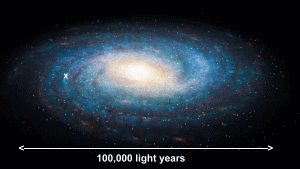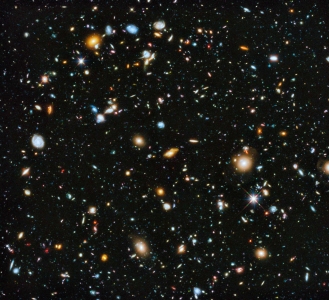 A light year is a distance. One light year is the distance that light will cover in one year. Light is very fast. In fact, Albert Einstein proved that nothing can move as fast as light does. Its speed in a vacuum is an incredible 300,000 kilometres in one second. It could travel around the Earth at the equator seven and a half times in the space of one second. Scientists have been trying to measure the speed of light for centuries. The difficulty they had was that, in ordinary circumstances here on Earth, it moves so fast as to be virtually instantaneous. It took advances in technology and some clever engineering to allow scientists to finally measure the speed accurately. You can learn about the struggle to measure light's speed here. Despite the amazing high speed at which light moves, the large distances between objects in space make that speed more easily measureable. For example, let's look at the distance to the moon. The moon's average distance from Earth is about 383,000 kilometres. Here is a diagram drawn to scale showing the Eath and moon, and a beam of light travelling between them.  The Earth is in orbit around the Sun. We are about 152,000,000 km from the Sun. Light takes about 8.4 minutes to get here.  Here is an interesting corollary to the fact that light takes a measureable amount of time to travel between bodies in space, because of the huge distances. It means that we can never see objects the way they are now, but only as they were in the past. When you see the sun in the sky, you are seeing it the way it was 8.4 minutes ago. If you peer into a telescope or a good camera while looking at Saturn, you are actually seeing it the way it looked about one hour and twenty-one minutes (81 minutes) ago. Now let's examine the distance we call one light year. We'll start smaller, with the distance light travels in just one minute. This is called one light minute. A light minute is 18,000,000 (18 million) kilometres. So from the examples above, the Earth is 8.4 light minutes from the Sun. We are 81 light minutes from Saturn. Now we're ready to talk about interstellar distances. The distances between stars are enormous. The nearest star system to us is Alpha Centauri, which is about 40,000,000,000,000 (forty trillion) km away. It takes the light from this nearby star a full 4.3 years to get here! So we can call its distance from us 4.3 light years. This number is much more convenient to use than the distance in kilometres. And the distances just keep getting bigger. Our star and hundreds of billions of others are held together by gravity into a vast collection of stars called a galaxy; our galaxy is called the Milky Way. It's a spiral galaxy with multiple arms. It's difficult to get a detailed picture of it because we're embedded in one of the arms, but it looks sort of like this:  Our Sun is located on one of the arms, shown by the 'X'. On the diagram you can see that our galaxy is roughly 100,000 light years from one end to the other. This is 1,000,000,000,000,000,000 km! 
Pictured at the right is a cluster of about 10,000 galaxies photographed by the Hubble Space Telescope that are over 10 billion light years away. What you see in the photo are the galaxies as they appeared more than 10 billion years ago. This is seeing back into the past, almost to the 'Big Bang' that began our universe. The galaxies visible in this photo each contain hundreds of billions of stars, and this is only one small slice of the sky imaged by Hubble. |